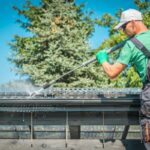A leaky roof can turn from a minor inconvenience into a major headache if left unaddressed. Whether caused by harsh weather, worn-out materials, or poor installation, roof leaks compromise your home’s safety, energy efficiency, and structural integrity. When water starts to drip or stains appear on your ceiling, the big question arises: Should you go for a temporary fix, or is it time for a permanent solution?
In this blog, we’ll break down both approaches, highlight their pros and cons, and help you determine which route is best for your roofing situation.
Understanding the Problem: What Causes Roof Leaks?
Before choosing a sealing solution, it’s important to understand what you’re dealing with. Roof leaks can stem from:
-
Damaged or missing shingles
-
Cracked flashing or vent boots
-
Clogged gutters
-
Ponding water on flat roofs
-
Age-related wear and tear
The signs can range from visible water dripping to discolored ceilings, mold growth, or musty odors. Regardless of the cause, swift action is essential.
Temporary Roof Leak Sealing Solutions
What Are They?
Temporary sealing methods are quick fixes designed to control or stop the leak until a more lasting repair can be made. These are especially helpful in emergencies or when professional help isn’t immediately available.
Common Temporary Fixes:
-
Roofing Tape or Patches – Waterproof tape designed for roof repairs can temporarily seal cracks or holes.
-
Tarping – Covering the damaged area with a tarp is a fast, effective way to divert water during heavy rain.
-
Spray Sealants – Aerosol-based sealants that create a waterproof layer over small leaks or cracks.
-
Roofing Caulk – Applied to seal small gaps around flashing or vents temporarily.
Advantages:
-
Quick application: Ideal for emergency situations.
-
Budget-friendly: Inexpensive materials available at most hardware stores.
-
Short-term relief: Buys you time to schedule a permanent fix.
Disadvantages:
-
Limited durability: These solutions wear out quickly under harsh weather.
-
Not suitable for large leaks: May only mask the problem temporarily.
-
Can hide ongoing damage: Risk of worsening internal issues if not addressed fully.
Permanent Roof Leak Sealing Solutions
What Are They?
Permanent solutions involve addressing the root cause of the leak and reinforcing the roof’s integrity. These methods are long-lasting and often require the help of a roofing professional.
Common Permanent Fixes:
-
Shingle Replacement – Replacing damaged or missing shingles helps restore your roof’s protective layer.
-
Flashing Repair or Replacement – Fixes leaks around chimneys, skylights, or roof joints.
-
Roof Membrane Sealing (for flat roofs) – Involves resealing or replacing waterproof membranes to stop leaks.
-
Partial or Full Re-Roofing – For widespread damage, replacing an entire section may be necessary.
Advantages:
-
Long-term protection: Designed to withstand the elements for years.
-
Enhances home value: Proper repairs maintain your home’s integrity.
-
Prevents further damage: Eliminates mold risk, rot, and insulation damage.
Disadvantages:
-
Higher initial cost: Quality materials and professional labor aren’t cheap.
-
Time-consuming: Repairs may take hours or even days, depending on the job.
-
May require permits or inspections: Depending on your location and repair type.
Temporary vs. Permanent: How to Choose
Choosing between a temporary or permanent fix depends on several factors:
✅ When to Use Temporary Solutions:
-
You need an immediate fix during a storm or weekend.
-
A small, localized leak is present and manageable.
-
You’re waiting for a contractor or planning future repairs.
-
Budget constraints demand a short-term patch for now.
✅ When to Choose Permanent Repairs:
-
The leak has recurred multiple times.
-
There are visible signs of long-term damage, such as rot or mold.
-
Your roof is aging or past its life expectancy.
-
You want to improve resale value or make your home safer.
Expert Advice: Use Both When Necessary
Often, the best approach is a combination. For instance, apply a temporary sealant to stop the immediate leak, then follow up with a professional inspection and permanent fix. This two-step strategy protects your home now and prevents more serious issues later.
Remember: temporary solutions are just that—temporary. Relying on them for too long can lead to hidden damage, costly repairs, and even structural failure.
Conclusion
Sealing a roof leak isn’t a one-size-fits-all situation. Temporary fixes can save your home in the moment, but permanent repairs are the key to long-term protection. Knowing when to use each—and why—will help you act quickly, make smart repair decisions, and avoid expensive damage down the road.
If you’re unsure what type of fix you need, it’s always wise to consult a professional roofing contractor. With the right approach, you can seal the problem today and shield your home for years to come.
- Temporary vs. Permanent Roof Leak Sealing Solutions
- Discover the key differences between temporary and permanent roof leak sealing solutions. Learn when to use quick fixes and when it’s time for a lasting repair to protect your home.
- Roof Leak
Related posts:
 Can Residential End of Lease Cleaning Help You Get Your Bond Back?
Can Residential End of Lease Cleaning Help You Get Your Bond Back?
 How Much Do Gutter Services Cost in Bradford in 2025 | Complete Price Guide
How Much Do Gutter Services Cost in Bradford in 2025 | Complete Price Guide
 Top-Rated Swimming Pool Remodeling in Hoover AL You Can Trust
Top-Rated Swimming Pool Remodeling in Hoover AL You Can Trust
 Comprehensive Guide to Services Offered by Professional Landscapers in Durham
Comprehensive Guide to Services Offered by Professional Landscapers in Durham
 Why Pet Owners Prefer WPC Decking for Safe, Durable Backyards
Why Pet Owners Prefer WPC Decking for Safe, Durable Backyards
 24/7 Emergency Plumber Near You – Fast, Reliable & Affordable!
24/7 Emergency Plumber Near You – Fast, Reliable & Affordable!
 Take Action Now to Ensure Complete Workplace OHS Safety Compliance
Take Action Now to Ensure Complete Workplace OHS Safety Compliance
 Small Bedroom Design/Small Bedroom Tips That Make a Big Impact
Small Bedroom Design/Small Bedroom Tips That Make a Big Impact







